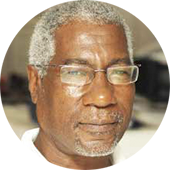“Commercialism allows for everyone to cash-in on the day, but not equally. And the excessive over-pricing can be ridiculous — like a public exhibition of traditional items of yesteryear below a notice saying ‘$5 for photos’; or those market vendors charging $10 for a small green ‘zaboka’ (avocado pear); or charging $10 for four small-to-medium sized ‘Bwigo’ (whelks in shells) in a small plastic bowl.”

I’D long stopped driving around the island for a panoramic view of national Jounen Kweyol celebrations. But I was persuaded to do just that on Sunday to upgrade preparations for my next TV programme (Earl@Large on DBS from Midday to 2:00p.m. every Sunday), during which I will focus on what Kweyol Day has become here.
Having been there when it all started, I can well tell how much we’ve stayed on track and how much we’ve gone off the mark.
We’ve moved from celebration of International Creole Day on the Sunday nearest to the official October 26 date to observance of a Creole Heritage Month. Every government department and business place observes Kweyol, staff and location sporting Madras colours the best and most they can. Kweyol music fills the air everywhere throughout October. And every community, village or town finds ways and means to identify with their creole heritage.
On Sunday, my early and slow ride down the East Coast to Vieux Fort showed much along the way. Every community had something Kweyol going, not a word or a song in English to be heard.
Our stops at Vieux Fort and Choiseul led to a unanimous conclusion that the celebration has simply become too commercialized for its own sake.
Commercialism allows for everyone to cash-in on the day, but not equally. And the excessive over-pricing can be ridiculous — like a public exhibition of traditional items of yesteryear below a notice saying ‘$5 for photos’; or those market vendors charging $10 for a small green ‘zaboka’ (avocado pear); or charging $10 for four small-to-medium sized ‘Bwigo’ (whelks in shells) in a small plastic bowl.
People do have a choice to buy or not, but it’s this sort of pricing that leads to loose calls for regulation – usually spelt or belted-out as ‘It’s time for the government to do something about that!’
We can also discuss and disagree forever on whether Kweyol is as understood as is being observed. Fact is, however, the language is less spoken and understood now than 40 years ago when it was being taught to small groups in classrooms, community centers, homes, even at the Royal Jail, Her Majesty’s Prison in Castries.
Today, Kweyol Language is still being taught at and through various degrees at universities in neighbouring Martinique and Guadeloupe, but not even in primary schools here; and the few here with Kweyol Degrees can only use them to a certain limited degree in Saint Lucia.
The sustained symbolism of translation of large aspects of the Governor General’s annual Throne Speech for 20 consecutive years is sadly no more.
After more than 40 years of accepting Kweyol as a proud part of our national heritage, the very notion of Saint Lucia as a bilingual nation is not reflected in official or personal communication in the way it should.
The Prime Minister’s Facebook Page on Sunday featured a Kweyol Day Message with him wearing a red shirt and his wife a yellow dress. The symbolism was noted, but the message was in English.
Unfortunately, there’s also an unintended and unguarded tendency to misrepresent Kweyol culture as the nothingness of the dirt-poor, presenting traditional forms and norms in negative ways that can appear to be ugly or comical, amusing or entertaining, but all dangerously misleading.
There’s also the question of purity versus adaptation.
A friend complained to a friend that he accepted an invitation to Jounen Kweyol at the Darren Sammy Cricket Ground Sunday — and at 9:00a.m, in lieu of electricity and water, breakfast consisted ‘Mac & Cheese’ and ‘Pasta’. The friend replied: ‘What did you expect? That’s Kweyol food for Saint Lucia’s One Percent!’
However, the first Kweyol food stall my friends and I stopped at just after 10:00a.m. on Sunday was closer to the real thing(s). It featured a very long menu under the simple title Dejner (Lunch). It included: Vyan Kochon Wosee Epi Go Manjay (Stewed Pork with Ground Provisions), Mashwen Wosee epi go Manje (Stewed Blackfish with Ground Provisions), Vyan Torti Wosee (Stewed Turtle Meat), Lambee Wosee (Stewed Conch), Shatoo Wosee (Stewed Octopus), Bouyon Kwab (Crab Bouillon), Hoomah (Lobster), Koff (Box Fish), Pwesson Woti (Roasted Fish), Vyn Kochon Woti (Roasted Pork), Fig ek Lamowee (Green Bananas and Saltfish), Bwapen epi Sadin (Breadfruit and Sardines) – and a very new delicacy called Vyan Shooval (Horse Meat).
The discussion spurred by the last-named dish on the menu of creole delicacies included the following unforgettable quip.
Observer #1: ‘It’s terrible that this horserace thing has got its way into Jounen Kweyol with people now selling horse meat for Looshans to eat.’
Observer #2: ‘If racehorses can have right-of-way in Vieux Fort today, why can’t they jump into a frying pan?’
Having tasted roasted horse meat on a beach in Micoud as a child, I can still say five decades later that those who haven’t tasted it don’t really know what they’re missing.
But that healthy confession apart, I do think we’re horsing around too much with our Kweyol heritage today.
Time to pull the reins and say: WhooooohBeff!












